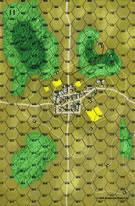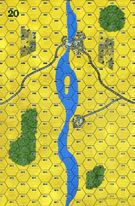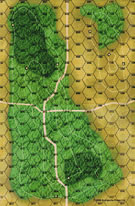|
Thunder from Heaven Iron Curtain #19 |
||
|---|---|---|
| (Attacker) United States | vs | Soviet Union (Defender) |
| Formations Involved | ||
|---|---|---|
| Soviet Union |  |
19th Guards Heavy Self-Propelled Artillery Regiment |
| Soviet Union |  |
26th "Zlatoustskaya" Rifle Division |
| United States |  |
17th "Golden Talon" Airborne Division |
| United States |  |
2nd "Indianhead" Infantry Division |
| United States |  |
741st Tank Battalion |

| Total | |
|---|---|
| Side 1 | 1 |
| Draw | 0 |
| Side 2 | 0 |
| Overall Rating, 1 vote |
|---|
|
5
|
| Scenario Rank: --- of 913 |
| Parent Game | Iron Curtain |
|---|---|
| Historicity | Alt-History |
| Date | 1948-10-01 |
| Start Time | 07:00 |
| Turn Count | 40 |
| Visibility | Day |
| Counters | 257 |
| Net Morale | 0 |
| Net Initiative | 0 |
| Maps | 8: 1, 11, 20, 4, 5, 7, 8, 9 |
| Layout Dimensions | 112 x 86 cm 44 x 34 in |
| Play Bounty | 239 |
| AAR Bounty | 171 |
| Total Plays | 1 |
| Total AARs | 1 |
| Battle Types |
|---|
| Bridge Control |
| Road Control |
| Urban Assault |
| Paradrops |
| Conditions |
|---|
| Off-board Artillery |
| Reinforcements |
| Scenario Requirements & Playability | |
|---|---|
| Battle of the Bulge | Maps + Counters |
| Eastern Front | Maps + Counters |
| Iron Curtain | Base Game |
| Road to Berlin | Maps + Counters |
| Introduction |
|---|
|
Both the Soviet Union and the United States developed large parachute-and glider-borne forces during the Second World War, and both ended up using them in combat more often as elite light infantry than in an air assault role. American airborne divisions would eventually have been called on to carry out their special function, if only because of the "airborne mafia" of generals working their way toward the top of the American command structure. |
| Conclusion |
|---|
|
Opposed airborne landings were already difficult in the early years of World War II, and resulted in disastrous losses for the attackers even when supposedly "successful." Yet they remained a staple of U.S. Army doctrine into the 21st century, though large-scale combat jumps have been rare: one Army battalion made a combat jump in Vietnam in February 1967, and no other large unit did so until the same unit landed in northern Iraq in February 2003. |
| AFV Rules Pertaining to this Scenario's Order of Battle |
|---|
|
| 1 Errata Item | |
|---|---|

|
The reduced direct fire value in Kursk: Burning Tigers is 4-4. (plloyd1010
on 2015 Jul 31)
|
| American Lighting Strike | ||||||||||||
|---|---|---|---|---|---|---|---|---|---|---|---|---|
Setup: The Soviets spread out their foot units to cover all the town hexes east of the main river that they are to defend. Per the conditions of the American paratroopers' drop, the Americans must attempt to land away from the Soviet anti-air guns. With this in mind, the Soviets their seven AA to cover as much of the open terrain as possible. The 76.2mm guns occupy the six entrenchments that are placed along the two roads to stop the American tanks. The Soviets defend the northern bridge at the town on Board 20, but opt to defend only the towns along the southern east-west route. Play: The Americans waste no time in beginning their airdrop, landing all of their airborne units and leaders as far away as possible from the Soviet units. The entire drop works perfectly, and over the next 45 minutes, the Americans east of the river scramble to reorganize and begin their attack from behind the Soviets' line. Meanwhile, as the American C-47's launch their men, the American army units attack in four groups. The northernmost group holds back their armor and pushes their foot units forward to confront the Soviet defense. The center group crosses the river in order to sweep the Soviet units in the middle of the map. The southern group crosses at the southern bridge, then split into two small continents, one moving north to capture a small turn, the second moving due east to flank the large town on Board 4. The paratroopers move to seize the northernmost town on the map, while the other half moves south and prepares to attack the town on Board 4, in co-ordination with the army units. The northernmost group begins their assault on the northern bridge, but begin to take severe casualties. The center group completes their river crossing. The southern group engages the town in the middle of the map, while the southernmost group prepares to strike the large town in the south with the paratroopers. The airborne units begin their assaults on the both the northernmost town and the southernmost town, quickly eliminating the light Soviet forces in the north, but having more difficulty with the units in the south. At the same time, the Americans attack the southern town from the west, completely surrounding the town on Board 4 with direct fire. The other half of the southern group begins their assaults in the middle of the map as well. The river crossing units move to attack the Soviets guarding the rest of the northern east-west road. At the northern bridge, the Americans, even with heavy losses, capture the bridge, but still have two town hexes to capture. In the southern town, the Soviets are beginning to crumble under the weight of the Americans' dual strike, while in the middle of the map, the Soviets are all but destroyed. The northern town beside the bridge remains in Soviet hands, but the Americans launch another assault to dislodge them. After two hours of assaults, the Americans in the north, after losing almost two-thirds of their force, finally capture the town, and send their armor through the capture the entire northern east-west road. In the southern town, the American army and airborne troops finally meet in the center of the town, having crushed the Soviet defenders, and also send some tanks to capture the rest of the southern road. Result: Total American Victory. Both the roads and bridges, as well as all the towns east of the river are now in American hands. The Victory Point Count stands at 71-320, with the Americans having an outstanding 249 point lead. |
||||||||||||
| 0 Comments |

 IrCu018
IrCu018 















































